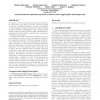Free Online Productivity Tools
i2Speak
i2Symbol
i2OCR
iTex2Img
iWeb2Print
iWeb2Shot
i2Type
iPdf2Split
iPdf2Merge
i2Bopomofo
i2Arabic
i2Style
i2Image
i2PDF
iLatex2Rtf
Sci2ools
SPAA
2006
ACM
2006
ACM
Modeling instruction placement on a spatial architecture
In response to current technology scaling trends, architects are developing a new style of processor, known as spatial computers. A spatial computer is composed of hundreds or even thousands of simple, replicated processing elements (or PEs), frequently organized into a grid. Several current spatial computers, such as TRIPS, RAW, SmartMemories, nanoFabrics and WaveScalar, explicitly place a program’s instructions onto the grid. Designing instruction placement algorithms is an enormous challenge, as there are an exponential (in the size of the application) number of different mappings of instructions to PEs, and the choice of mapping greatly affects program performance. In this paper we develop an instruction placement performance model which can inform instruction placement. The model comprises three components, each of which captures a different aspect of spatial computing performance: inter-instruction operand latency, data cache coherence overhead, and contention for processin...
Distributed And Parallel Computing | Instruction | Instruction Placement | SPAA 2006 | Spatial Computers |
Related Content
| Added | 14 Jun 2010 |
| Updated | 14 Jun 2010 |
| Type | Conference |
| Year | 2006 |
| Where | SPAA |
| Authors | Martha Mercaldi, Steven Swanson, Andrew Petersen, Andrew Putnam, Andrew Schwerin, Mark Oskin, Susan J. Eggers |
Comments (0)

